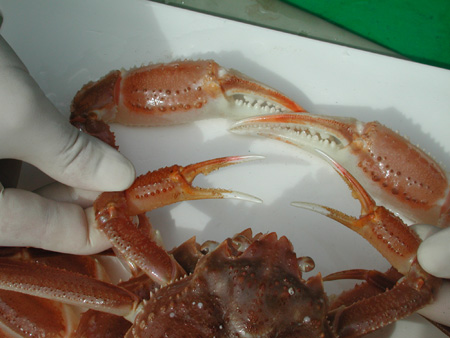Adaptation
The snow crab has numerous adaptations in order to enhance its protection, food acquisition, and overall efficiency as an organism.
Legs
Although Chionoecetes opilio lives in a marine environment, it has four pairs of walking legs. This is due to the fact that the snow crab lives on the bottom of the body of water. This allows for faster movement across the substrate. It also serves as a protection device, as it allows for a more efficient means of burrowing into the sand to get away from predators.
 Claws
Claws
Snow crabs have two front claws called chelipeds. These are used for food acquisition and allow the crab to tear apart a large array of prey from fish to clams. They also serve as a tool for burying themselves into the substrate to protect themselves from predators.
Color
Due to the fact that these crabs are generally found on the floor of oceans, they are typically in darker areas. With this, the dorsal colors of the snow crab are generally darker in color. These colors can range from a brown to a red, depending upon the environment that the crab lives in which can be strictly sandy or it can have vegetation or reefs.
Carapace
Snow crabs are most vulnerable when they are undergoing the
molting process. In order to make these crabs less vulnerable,
they have adapted and have a hard, chitinous outer shell called a
carapace. This helps protect the snow crab from potential
predators, making it more difficult for organisms such as octopi and
cod to get to the nutritional portion of the crab. The
carapace also protects this species from different fungal, bacterial
and parasitic diseases. The most common disease amongst this
species is known as Bitter Crab Disease which is caused by a
parasitic dinoflagellate. The carapace is also bumpy which allows for the snow crab to
"decorate" itself with sediment. This is a means of camouflage
and is a protective device used against predators.
make these crabs less vulnerable,
they have adapted and have a hard, chitinous outer shell called a
carapace. This helps protect the snow crab from potential
predators, making it more difficult for organisms such as octopi and
cod to get to the nutritional portion of the crab. The
carapace also protects this species from different fungal, bacterial
and parasitic diseases. The most common disease amongst this
species is known as Bitter Crab Disease which is caused by a
parasitic dinoflagellate. The carapace is also bumpy which allows for the snow crab to
"decorate" itself with sediment. This is a means of camouflage
and is a protective device used against predators.
Gills
Chionoecetes opilio have internal gills that allow for the uptake of oxygen and exchange of other gases. They have specialized devices called elongate exopods which are located on the maxilla of the crab and generate a current of water from vibrations. This moves fresh water over the gills and allows for gas exchange to occur.
Intestinal Tract
Due to its primarily carnivorous lifestyle, the intestinal tract Chionoecetes opilio is shortened. Prey of this species is high in nutrient content and therefore does not require a long intestinal tract as an organism with a herbacious lifestyle would. There are also multiple villi and microvilli along the intestinal tract for increased surface area and more efficient nutrient uptake.
Open Circulatory System
The snow crab has an open circulatory system which is less energy consuming than a closed circulatory system. Snow crabs are not required to move very quickly in the environment they are found in because they find most of their prey within the substrate that they live on, and they burrow into the substrate for protection from predators. With that, they are fairly sedentary animals compared to other organisms that are found in the same habitat, and do not require a high demand of oxygen to survive. An open circulatory system deems to be perfect for this lifestyle!
